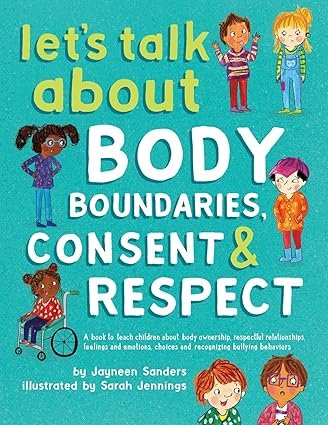1. Introduction

In Let’s Talk About Body Boundaries, Consent, and Respect, Jayneen Sanders explores the critical topic of body autonomy for young children. She highlights the importance of understanding personal space and respecting others. Sarah Jennings illustrates the 42-page book, making it engaging for children aged 4 to 10. Through relatable scenarios and simple dialogue, the book teaches consent and boundaries effectively.
Jayneen Sanders brings her experience as a teacher and child safety advocate to this work. As a mother of three, she understands the need for empowering children with knowledge. Through her publishing company, Educate2Empower, she creates meaningful resources for child safety education. Moreover, she helps children recognize and respond to unsafe situations confidently.
Reader Engagement: What are your thoughts on teaching young children about consent and body boundaries? How early do you think these lessons should begin? Share your experiences in the comments below!
2. Why Should You Read This?
This book stands out because it tackles sensitive topics with ease and clarity. It provides guidance for parents and educators who may find these discussions challenging. Moreover, the content is both age-appropriate and comprehensive, simplifying complex ideas for young children. It introduces concepts like personal space and respect in a relatable manner.
The relevance of Let’s Talk About Body Boundaries is clear in today’s world. Conversations about consent and respect are increasingly important for young minds. The book teaches children to understand and protect their own boundaries. Additionally, it fosters empathy by emphasizing respect for others’ boundaries. This dual focus makes it valuable for parents, teachers, and caregivers alike. Ultimately, it serves as a crucial tool for instilling these lessons early.
In comparison to other books in this genre, Sanders’ work is unique because it goes beyond just outlining the rules—it facilitates open dialogue between children and adults, which can lead to deeper understanding and internalization of these principles.
3. Key Teachings and Themes
At the heart of Let’s Talk About Body Boundaries, Consent, and Respect are three essential themes. It emphasizes body ownership, respect for personal space, and understanding consent. These concepts are explained in simple terms that young readers can easily grasp. Moreover, the book encourages children to apply these lessons in daily interactions.
It also addresses bullying, adding another layer of importance. Through relatable scenarios, it shows what happens when boundaries are crossed. This naturally leads to discussions about how kids can respond in such situations. Additionally, it promotes self-advocacy by teaching children to speak up when they feel uncomfortable. These lessons empower young readers to set boundaries and protect themselves confidently.
Notable Quotes and Passages:
1. “Your body is your own, and no one has the right to touch it without your permission.”
2. “When we ask for permission before touching someone, we show them respect. It’s important to listen to their answer.”
These passages highlight the book’s empowering messages, offering children clear and actionable lessons on consent and body boundaries.
4. How This Book Can Help You
This book equips young readers with the knowledge and confidence they need to protect themselves and understand the importance of respecting others. For parents and educators, it provides a framework for having conversations that can often feel uncomfortable but are absolutely necessary.
The interactive nature of the book encourages children to think critically about real-life situations, promoting empathy and self-awareness. By fostering open discussions about consent and personal space, this book can help reduce incidents of bullying and empower children to advocate for themselves in tricky situations.
5. Writing Style and Structure
Jayneen Sanders’ writing is clear, direct, and perfectly suited to a young audience. The book is structured around simple, relatable scenarios, each of which is accompanied by discussion points that encourage children to reflect on what they’ve learned.
The illustrations by Sarah Jennings are colorful and engaging, helping to keep young readers’ attention while reinforcing the text’s key messages. The balance between the visual elements and the narrative makes the book accessible, even to early readers.
One of the most effective elements of the structure is the inclusion of questions after each scenario. This invites children to actively engage with the material, prompting thoughtful responses and discussions with adults.
6. Criticism of the Book
While Let’s Talk About Body Boundaries, Consent, and Respect does an excellent job of introducing these important concepts, some parents have mentioned that certain terms or ideas may be too complex for younger children. Adjusting the language or breaking the content into smaller, digestible parts may be necessary for the youngest readers.
Additionally, at just 42 pages, the book may feel brief to some readers. Parents and educators may need to supplement it with additional resources or discussions to fully address the topics covered.
7. Why Summary Is Not Enough
A summary of this book would miss the rich, interactive nature of the discussions it fosters. Reading the book allows children to experience the scenarios firsthand, engaging with the questions and illustrations in ways that a summary simply cannot capture. The real value comes from the conversations that unfold as children process each scenario, making this more than just a book—it’s a tool for meaningful learning and reflection.
8. Thought-Provoking Debates
One potential point of debate sparked by the book is how early we should start teaching children about consent. While some believe these lessons are crucial from a young age, others may feel that concepts like body autonomy and boundaries are too complex for preschool-aged children. This discussion can lead to broader conversations about child development, education, and how best to introduce sensitive topics.
Another debate centers around cultural norms regarding personal space and boundaries, as different cultures have varying expectations of physical touch and interaction. The book’s emphasis on respect and consent can help bridge these cultural differences but also invites further reflection on how to approach such lessons in diverse environments.
9. Who Should Buy or Read This?
This book is ideal for parents, caregivers, and educators of children aged 4 to 10. It’s a perfect resource for initiating important conversations about personal space, consent, and respect. Additionally, it makes an excellent gift for anyone looking to instill these values in young children early on, providing a foundation that will serve them well into adulthood.
10. Reasons Not to Buy/Read
– You’ve Already Read Similar Content Elsewhere: If your child is already familiar with similar topics through other books, this might feel repetitive.
– Lack of Interest in the Topic: For families who don’t prioritize discussions about body autonomy or respect, this book may not resonate.
– Not a Priority: If teaching about consent and personal space isn’t an immediate priority, you may opt to explore other topics first.
11. Conclusion
Let’s Talk About Body Boundaries, Consent, and Respect is an essential resource for parents, teachers, and caregivers. It tackles complex and sensitive topics with simplicity and empathy, providing children with valuable life lessons that will protect and empower them. The book’s interactive format and relatable scenarios make it both an educational tool and a conversation starter, ensuring that children understand the importance of respecting their own and others’ personal space.
12. Final Recommendation
This book is a must-read for anyone responsible for guiding young children through the complex world of social interactions. Whether you’re a parent, educator, or caregiver, Let’s Talk About Body Boundaries, Consent, and Respect will help you instill vital values in children that will serve them for life. With its clear messaging, engaging illustrations, and practical lessons, it deserves a place on every child’s bookshelf. Rating: 4.7/5.
A Thoughtful Perspective from sobersextext.com
If you’ve come across this review through my blog on sobersextext.com, I truly appreciate your curiosity and engagement. On sobersextext.com, we focus on breaking down essential topics around sex education that are often considered taboo or overlooked in casual discussions. “Let’s Talk About Body Boundaries, Consent, and Respect” by Jayneen Sanders was recommended as a valuable tool for parents and educators to guide children in understanding the importance of body boundaries and consent. This book empowers children to recognize the difference between good touch and bad touch, creating a safe space for them to express themselves confidently. Here on awareandbeware.com, I offer a thorough review to help you decide if this book fits your needs, whether you’re looking to instill trust, safety, or mutual respect in your child’s development.
If you haven’t yet visited the blog How to Teach Your Child About Safe Touch? on sobersextext.com, I encourage you to explore it for a nuanced perspective on how this product helps establish a foundation of awareness and security for the future.

